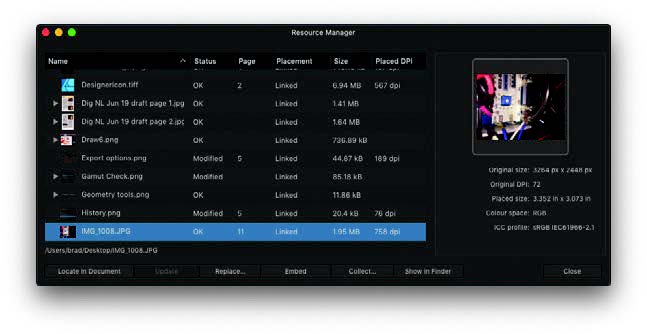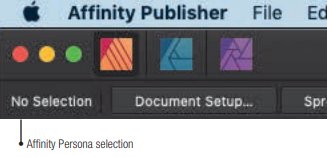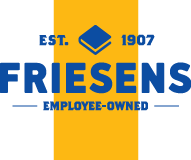September 29, 2020
AFFINITY PUBLISHER
- by Brad Schmidt – Colour Technical Support Specialist

After evaluating the other programs in the Affinity lineup, it is time to examine the final program in this collection from Serif. Affinity Publisher is the long-anticipated program in the Affinity family. The introduction of Affinity Designer in October 2014 was an interesting addition to the market, but on its own not considered an alternative to the long-standing players in this space. Then in July 2015, Serif released Affinity Photo, which brought together a duo of programs for drawing and photo workflows. The one missing piece to this puzzle was a page layout program to bring these together into a compelling package. Without a program for building pages, it would be difficult to consider this offering as an alternative workflow. With Designer and Photo being released within less than a year, there was some expectation that a page layout program would follow shortly after. This turned out not to be the case. There was speculation online that Affinity Publisher would flounder in beta forever and might never be released as a full-fledged software package. Then, after nearly four years, in June 2019, Affinity Publisher was released to the public, completing the triad.
Depending on the type of publications you create, there will be different tools that are critical to consider in a page layout program as a possible alternative to your current software suite. These are the main elements of a page layout program that I consider essential.
Page management is an important aspect of any book. I was encouraged to see support for multiple page sizes, including configurations for single pages or facing pages layouts. The program has support for Master Pages, providing the ability to define common layouts to maintain consistency. Placeholders such as page numbers can be inserted into text boxes on the Master Pages. When inserting new pages, a Master Page can be selected as a base for any new page.
Paragraph Styles is an area that is critical in order to create consistency within a document. Another tool that works alongside Paragraph Styles is Character Styles. These are often used together when forming an overall look for a piece of work. Affinity Publisher offers a full set of options when using Paragraph Styles. Options include next style, font family, font weight, paragraph alignment, indents, tab stops, and drop caps. Character Styles can be used to create overrides to Paragraph Styles.
Affinity Publisher also utilizes text frames. Text frames support the ability to create a multiple column frame with an option to set the space between columns. A feature that I was surprised to find was the ability to change an individual column width so the columns could be custom widths. I did not find any options to create headings that would stretch across two or more columns. This could only be achieved by using a separate text box for the heading. This is something to consider for an improvement to future releases of Affinity Publisher. Text frames can also be linked to flow text from one text frame to another.

Support for image placement is also another area that needs to be solid in a page layout program. Affinity Publisher offers standard tools for working with images. Images can be placed, rotated, cropped, and scaled. There is also an option for how to handle the interaction of images and text. Wrap options allow for various ways to flow text around images. Drop shadows and other transparency effects can be applied to images. For image management, there is a Resource Manager that contains a listing of all the images that have been placed in the document. Here images can be updated, embedded, or replaced. Image resolution is also displayed in a column to quickly identify low resolution images found in the document.
Affinity Publisher, like the other programs in the collection, has support for multiple colour models. These include options for RGB, CMYK, LAB, and Grayscale. Along with these colours there is also support for the various PANTONE colours for spot colour selection. These can be defined in the Swatches palette.
Another feature that is consistent with other programs in the collection is the History panel. History is presented as a slider and list of edits. The slider is used to quickly perform multiple undos or slide forward to bring the document back to the original state. The history can even be saved with the document so that undos can be performed on a previously saved document.

Affinity Publisher shares the same document format with Photo and Designer, so it is actually possible to open a document in any of the programs. This speaks to the tight integration of these applications. In fact, Affinity Publisher has a feature called Persona that fully integrates the other programs into the application. This integration allows you to select a picture in Publisher, and then switch the Photo Persona to make colour adjustment using Levels, Curves, or other Photo tools, all without even leaving the application. This is one of the hidden strengths of this software collection.
Affinity Publisher offers multiple options when exporting to PDF, including options for down-sampling images, and ICC profile conversion, including bleeds and printer marks. Fonts can be embedded in the PDF, which is critical for a print environment. During testing, I found that some fonts were problematic when using the Subset fonts option. We had good success with documents that did not subset fonts.
It will take time to become familiar with the location of various tools and functions, but I found the program very intuitive to use. Each company’s software has a different layout and different ways of approaching tasks. The learning curve is not very steep if you are proficient in other programs in this space.
One area that did not work as expected was how documents were handled. I loaded a second document while an unsaved document was open. The unsaved document closed without providing an option to save it. This is likely a bug that needs to be fixed.
The challenge when considering any new program is all the legacy documents that exist in the old format. I remember when InDesign was first released, the ability to open QuarkXPress documents was helpful in accelerating this transition. When Affinity Publisher first released, it did not open any other desktop publishing file types. This is a factor we thought would make the switch to Affinity Publisher more compelling. I was quite surprised to see that Affinity Publisher has now included the ability to open InDesign IDML documents in the latest update.
The question remains, will publishers use this new set of programs for designing book projects, or will it remain on the peripheral of desktop publishing? As with other programs that are not officially supported by Friesens for book production, there is always the option to provide PDF files. I am aware of at least one project to date that we printed where the designer used Affinity Publisher. When using a new software package, I encourage designers to send a test PDF for verification so we can confirm the document will flow smoothly through production and have good print results.







